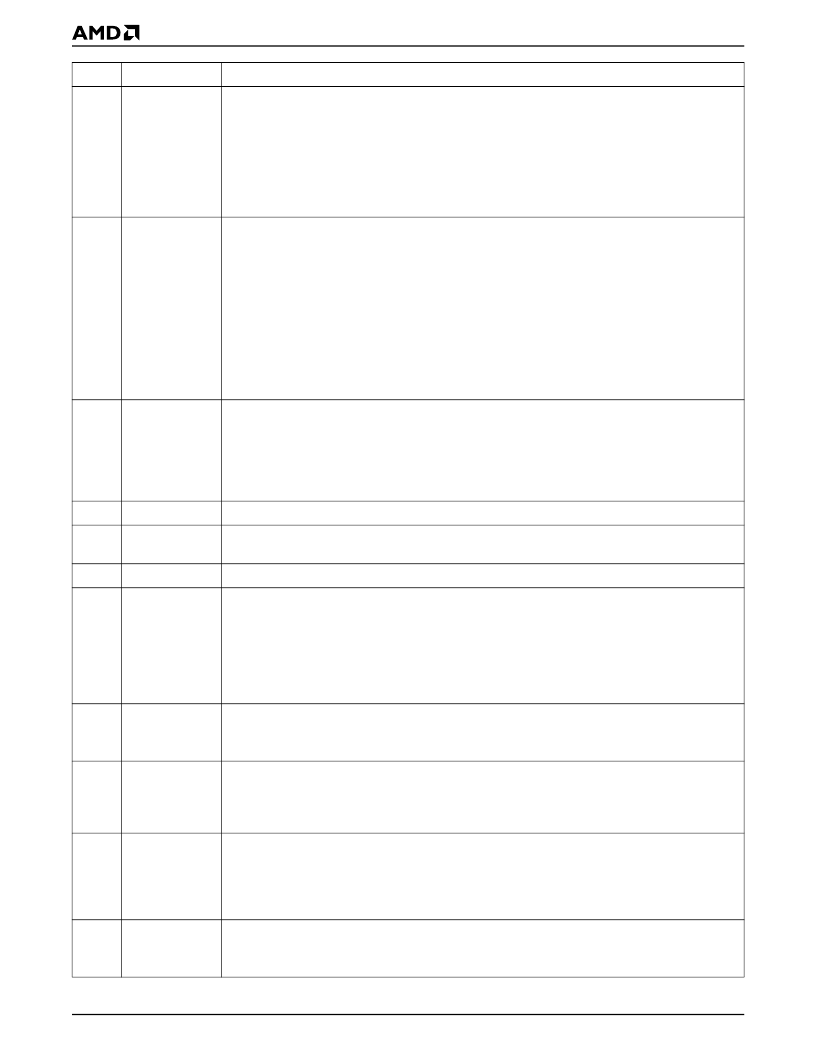- 您現(xiàn)在的位置:買賣IC網(wǎng) > PDF目錄366551 > AM79C976KCW (ADVANCED MICRO DEVICES INC) PCnet-PRO⑩ 10/100 Mbps PCI Ethernet Controller PDF資料下載
參數(shù)資料
| 型號: | AM79C976KCW |
| 廠商: | ADVANCED MICRO DEVICES INC |
| 元件分類: | 微控制器/微處理器 |
| 英文描述: | PCnet-PRO⑩ 10/100 Mbps PCI Ethernet Controller |
| 中文描述: | 1 CHANNEL(S), 100M bps, LOCAL AREA NETWORK CONTROLLER, PQFP208 |
| 封裝: | PLASTIC, QFP-208 |
| 文件頁數(shù): | 132/309頁 |
| 文件大小: | 2070K |
| 代理商: | AM79C976KCW |
第1頁第2頁第3頁第4頁第5頁第6頁第7頁第8頁第9頁第10頁第11頁第12頁第13頁第14頁第15頁第16頁第17頁第18頁第19頁第20頁第21頁第22頁第23頁第24頁第25頁第26頁第27頁第28頁第29頁第30頁第31頁第32頁第33頁第34頁第35頁第36頁第37頁第38頁第39頁第40頁第41頁第42頁第43頁第44頁第45頁第46頁第47頁第48頁第49頁第50頁第51頁第52頁第53頁第54頁第55頁第56頁第57頁第58頁第59頁第60頁第61頁第62頁第63頁第64頁第65頁第66頁第67頁第68頁第69頁第70頁第71頁第72頁第73頁第74頁第75頁第76頁第77頁第78頁第79頁第80頁第81頁第82頁第83頁第84頁第85頁第86頁第87頁第88頁第89頁第90頁第91頁第92頁第93頁第94頁第95頁第96頁第97頁第98頁第99頁第100頁第101頁第102頁第103頁第104頁第105頁第106頁第107頁第108頁第109頁第110頁第111頁第112頁第113頁第114頁第115頁第116頁第117頁第118頁第119頁第120頁第121頁第122頁第123頁第124頁第125頁第126頁第127頁第128頁第129頁第130頁第131頁當前第132頁第133頁第134頁第135頁第136頁第137頁第138頁第139頁第140頁第141頁第142頁第143頁第144頁第145頁第146頁第147頁第148頁第149頁第150頁第151頁第152頁第153頁第154頁第155頁第156頁第157頁第158頁第159頁第160頁第161頁第162頁第163頁第164頁第165頁第166頁第167頁第168頁第169頁第170頁第171頁第172頁第173頁第174頁第175頁第176頁第177頁第178頁第179頁第180頁第181頁第182頁第183頁第184頁第185頁第186頁第187頁第188頁第189頁第190頁第191頁第192頁第193頁第194頁第195頁第196頁第197頁第198頁第199頁第200頁第201頁第202頁第203頁第204頁第205頁第206頁第207頁第208頁第209頁第210頁第211頁第212頁第213頁第214頁第215頁第216頁第217頁第218頁第219頁第220頁第221頁第222頁第223頁第224頁第225頁第226頁第227頁第228頁第229頁第230頁第231頁第232頁第233頁第234頁第235頁第236頁第237頁第238頁第239頁第240頁第241頁第242頁第243頁第244頁第245頁第246頁第247頁第248頁第249頁第250頁第251頁第252頁第253頁第254頁第255頁第256頁第257頁第258頁第259頁第260頁第261頁第262頁第263頁第264頁第265頁第266頁第267頁第268頁第269頁第270頁第271頁第272頁第273頁第274頁第275頁第276頁第277頁第278頁第279頁第280頁第281頁第282頁第283頁第284頁第285頁第286頁第287頁第288頁第289頁第290頁第291頁第292頁第293頁第294頁第295頁第296頁第297頁第298頁第299頁第300頁第301頁第302頁第303頁第304頁第305頁第306頁第307頁第308頁第309頁

132
Am79C976
8/01/00
P R E L I M I N A R Y
29
LEDPE
LED Program Enable. When LEDPE is set to 1, programming of the LED functions through BCR4,
BCR5, BCR6, and BCR7 is enabled. When LEDPE is cleared to 0, programming of LED functions
through these registers is disabled. Writes to these registers will be ignored. However, LEDPE does
not affect the programming of LED functions through the memory mapped LED registers, LED0,
LED1, LED2 and LED3. The memory-mapped LED registers are always enabled, regardless of the
state of LEDPE.
This bit is an alias of BCR2, bit 12. It is included only to allow programming from the EEPROM for
compatibility with legacy software.
28
DWIO
Double Word I/O. When set, this bit indicates that the Am79C976 controller is programmed for
DWord I/O (DWIO) mode. When cleared, this bit indicates that the Am79C976 controller is
programmed for Word I/O (WIO) mode. This bit affects the I/O Resource Offset map and it affects
the defined width of the Am79C976 controllers I/O resources. See the DWIO and WIO sections for
more details.
The initial value of the DWIO bit is determined by the programming of the EEPROM.
The value of DWIO can be altered automatically by the Am79C976 controller. Specifically, the
Am79C976 controller will set DWIO if it detects a DWord write access to offset 10h from the
Am79C976 controller I/O base address (corresponding to the RDP resource).
This bit is an alias of BCR18, bit 7. It is included only to allow programming from the EEPROM for
compatibility with legacy software.
27
APROMWE
Address PROM Write Enable. The Am79C976 controller contains a 16-byte shadow RAM on board
that emulates a small PROM that was used in conjunction with early AMD Ethernet controllers.
Accesses to Address PROM I/O space will be directed to this RAM. When APROMWE is set to 1,
then write access to the shadow RAM will be enabled.
This bit is an alias of BCR12, bit 8. It is included only to allow programming from the EEPROM for
compatibility with legacy software.
26-24
RES
Reserved locations. Written as zeros and read as undefined.
23
VAL2
Value bit for byte 2. The value of this bit is written to any bits in the CMD2 register that correspond
to bits in the CMD2[22:16] bit map field that are set to 1.
22-21
RES
Reserved locations. Written as zeros and read as undefined.
20
FDRPA
Full-Duplex Runt Packet Accept. When FDRPA is cleared to 0 and full-duplex mode is enabled, the
Am79C976 controller will only receive frames that meet the minimum Ethernet frame length of 64
bytes. Receive DMA will not start until at least 64 bytes or a complete frame have been received.
By default, FDRPA is cleared to 0. When FDRPA is set to 1, the Am79C976 controller will accept
any frame of 12 bytes or greater, and receive DMA will start according to the programming of the
receive FIFO watermark.
This bit is the inverse of BCR9, bit 2.
19
RPA
Runt Packet Accept. This bit forces the Am79C976 controller to accept runt packets (packets
shorter than 64 bytes). The minimum packet size that can be received is 12 bytes.
This bit is an alias of CSR124, bit 3.
18
DRCVPA
Disable Receive Physical Address. When set, the physical address detection (Station or node ID)
of the Am79C976 controller will be disabled. Frames addressed to the node
’
s individual physical
address will not be recognized.
This bit is an alias of CSR15, bit 13.
17
DRCVBC
Disable Receive Broadcast. When set, disables the Am79C976 controller from receiving broadcast
messages. Used for protocols that do not support broadcast addressing, except as a function of
multicast. DRCVBC is cleared by activation of H_RESET or S_RESET (broadcast messages will
be received) and is unaffected by STOP.
This bit is an alias of CSR15, bit 14.
16
PROM
Promiscuous Mode. When PROM = 1, all incoming receive frames are accepted, regardless of
their destination addresses.
This bit is an alias of CSR15, bit 15.
Bit
Name
Description
相關PDF資料 |
PDF描述 |
|---|---|
| AM79C978AKCW | Single-Chip 1/10 Mbps PCI Home Networking Controller |
| AM79C978AVCW | Single-Chip 1/10 Mbps PCI Home Networking Controller |
| AM79C978 | Single-Chip 1/10 Mbps PCI Home Networking Controller |
| AM79C981 | Integrated Multiport Repeater Plus⑩ (IMR+⑩) |
| AM79C981JC | Integrated Multiport Repeater Plus⑩ (IMR+⑩) |
相關代理商/技術參數(shù) |
參數(shù)描述 |
|---|---|
| AM79C976KD | 制造商:Advanced Micro Devices 功能描述:ETHERNET:MEDIA ACCESS CONTROLLER (MAC) |
| AM79C976KF | 制造商:Advanced Micro Devices 功能描述:Ethernet CTLR Single Chip 10Mbps/100Mbps 3.3V 208-Pin PQFP 制造商:AMD (Advanced Micro Devices) 功能描述:Ethernet CTLR Single Chip 10Mbps/100Mbps 3.3V 208-Pin PQFP |
| AM79C976KI | 制造商:Advanced Micro Devices 功能描述:Ethernet CTLR Single Chip 10Mbps/100Mbps 3.3V 208-Pin PQFP 制造商:AMD (Advanced Micro Devices) 功能描述:Ethernet CTLR Single Chip 10Mbps/100Mbps 3.3V 208-Pin PQFP |
| AM79C976KIW | 制造商:AMD 制造商全稱:Advanced Micro Devices 功能描述:PCnet-PRO⑩ 10/100 Mbps PCI Ethernet Controller |
| AM79C978 | 制造商:AMD 制造商全稱:Advanced Micro Devices 功能描述:Single-Chip 1/10 Mbps PCI Home Networking Controller |
發(fā)布緊急采購,3分鐘左右您將得到回復。